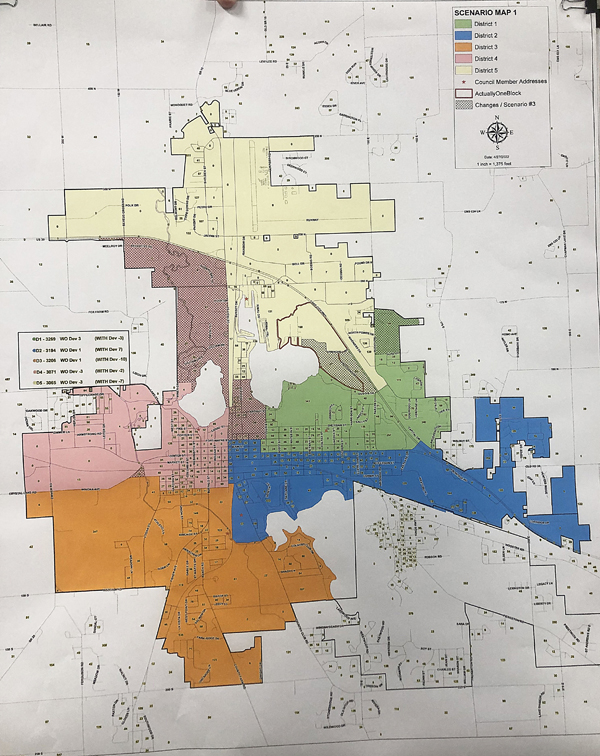U.S. 30 and its potential future as a freeway, as well as future growth of the city, were sizeable factors in the Warsaw Common Council coming to a consensus Monday on a redistricting map for the city.
The Council redistricting map will be forwarded to Kosciusko County Clerk Ann Torpy for her review as the next step with a number of steps to follow – including public hearings – before it’s adopted.
At the Council’s work session on the redistricting Monday, they were presented with the current district map and two redistricting options. Council members Diane Quance, Mike Klondaris and President Jack Wilhite served on the committee that came up with the maps, along with GIS coordinator Mary Haberman and the Warsaw Planning Department. Option 1 was the map the Council agreed upon Monday.
Starting the redistricting workshop, Mayor Joe Thallemer told the Council, “As you all know, the importance of redistricting is to try to make the new districts as compact and equal as possible as far as number of constituents.”
He said the Council had to respect the U.S. Census block boundaries, which Haberman was able to help the committee do with the GIS map. The boundaries can not be split up.
“The goal tonight is to try to come to a consensus because, before we bring one of these maps to the Council for a vote, we need to have approval by the county clerk, and she has worked with us. Ann Torpy has been instrumental in working with us, making sure that this is all done properly,” Thallemer said. “Ultimately, this is a Council decision.”
Thallemer said he has input and veto power, but the decision is the Council’s.
Wilhite said the map goes to Torpy for review to make sure the Census blocks are respected, which are set by the federal government. Torpy also will look at what precincts may have to be changed a little bit because once the Council is finished with the redistricting, the Council can’t split a precinct, he said. After Torpy’s review, Wilhite said the district map will come back to the Council for two meetings, including a public hearing.
“Once we have voted on it and moved it on, it will go back to Ann. She will present it to the Commissioners and the Commissioners have to vote on this as well,” Wilhite said. Eventually, the map goes to the state for approval.
He said they don’t anticipate any problems with the map, but that’s why they want to get it done a little early – in case anything comes up. The deadline to have it completed is the day after the general election – Nov. 8. City elections are in 2023.
Wilhite said the Council’s charge is to keep the districts balanced within 10% population-wise, not geographically. Each district also must be contiguous.
City Planner Justin Taylor said the current districts – which were created 10 years ago – have deviations of as high as 50% and they want to get that back down to around 10%. The maps presented to the Council on Monday had population numbers for districts as they are now and numbers that included projected development.
Warsaw Community Economic and Development Director Jeremy Skinner said, “Some districts are growing rapidly, some not as much. Obviously, District 4 is the biggest challenge because it’s the bulk of the urban and not much growth, so keep that in mind.”
On the new map, District 4 encompasses the area about south of U.S. 30, west of Ind. 15, north of Winona Avenue and mostly east of Zimmer Road.
The Council studied the maps and discussed what they saw for about an additional half hour.
Klondaris thought it would be a good idea if the rest of the Council had an explanation as to why the two maps looked the way they did.
Thallemer said, “One of the maps basically takes into account areas that we have annexed and reconsidered through Building & Planning and Community & Economic Development departments that we’re going to see growth. … We tried to anticipate where the growth was going to be. Without growth would be basically just taking the raw numbers and moving these districts around, trying to come as close as we can. Now, taking into account future growth.”
Skinner said there wasn’t too much difference between Option 1 and 2 except U.S. 30 is a divider line in Option 1 between Districts 4 and 5 and keeps neighborhoods more intact, while Option 2 uses Ind. 15 more as a divider line.
Councilman Jeff Grose asked if District 2 was going to grow more. Skinner said yes because of 2-1/2 subdivisions and 60 acres undeveloped yet. “It’s growth potential is pretty high,” Skinner said. District 3 also is pretty high. “There is some potential for growth in District 4, but not nearly what we have in 2 and 3.”
Grose represents District 1. Josh Finch represents District 2; Klondaris, District 3; Jerry Frush, District 4; and Quance represents District 5. The two at-large Council members are Cindy Dobbins and Wilhite.
Skinner said there are a lot of unknowns regarding future development, but he didn’t like the districts crossing U.S. 30 at this point.
“(Option) 1 is also a little better on both deviation points, so future growth and existing conditions it performs a little better by 1% point,” Taylor said.
Finch said initially, for aesthetic reasons, he liked Option 2, but after further discussion and study, he preferred Option 1. Dobbins said she liked that in Option 1 District 4 didn’t cross U.S. 30.
Thallemer said U.S. 30 kind of came late in the committee’s discussion. “30 could have quite an impact,” he said.
After the full Council agreed on Option 1, Thallemer said the map will be sent over to Torpy to let her look at it. “If she makes changes, it could impact some of these numbers and then we’d come right back to this group again. We’re not going to do anything until she gives us the thumbs up. If she is able to make the changes without impacting the numbers, obviously, we’ll have our hearing but if it significantly impacts what we’ve talked about here, we’ll start back with our committee,” he said.





